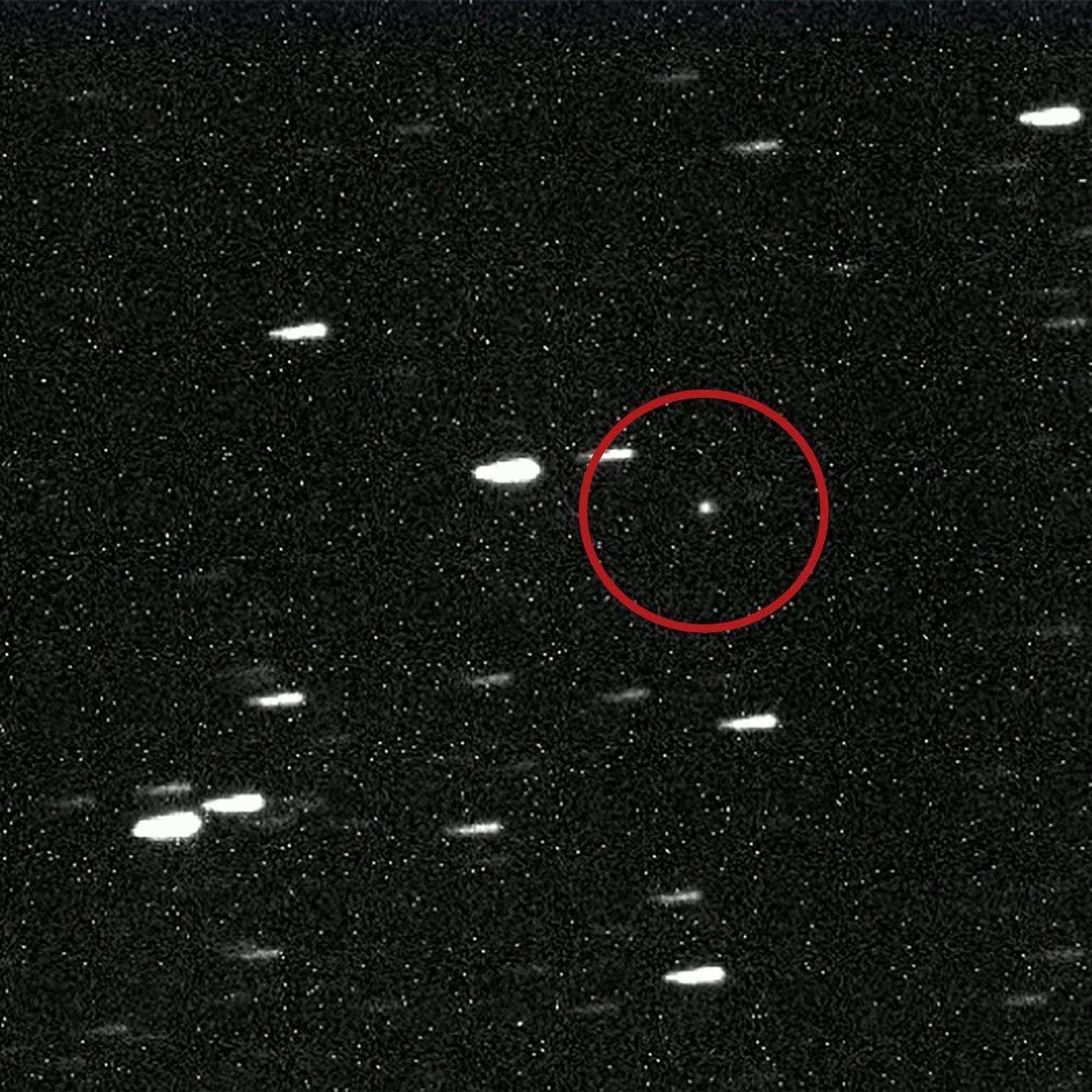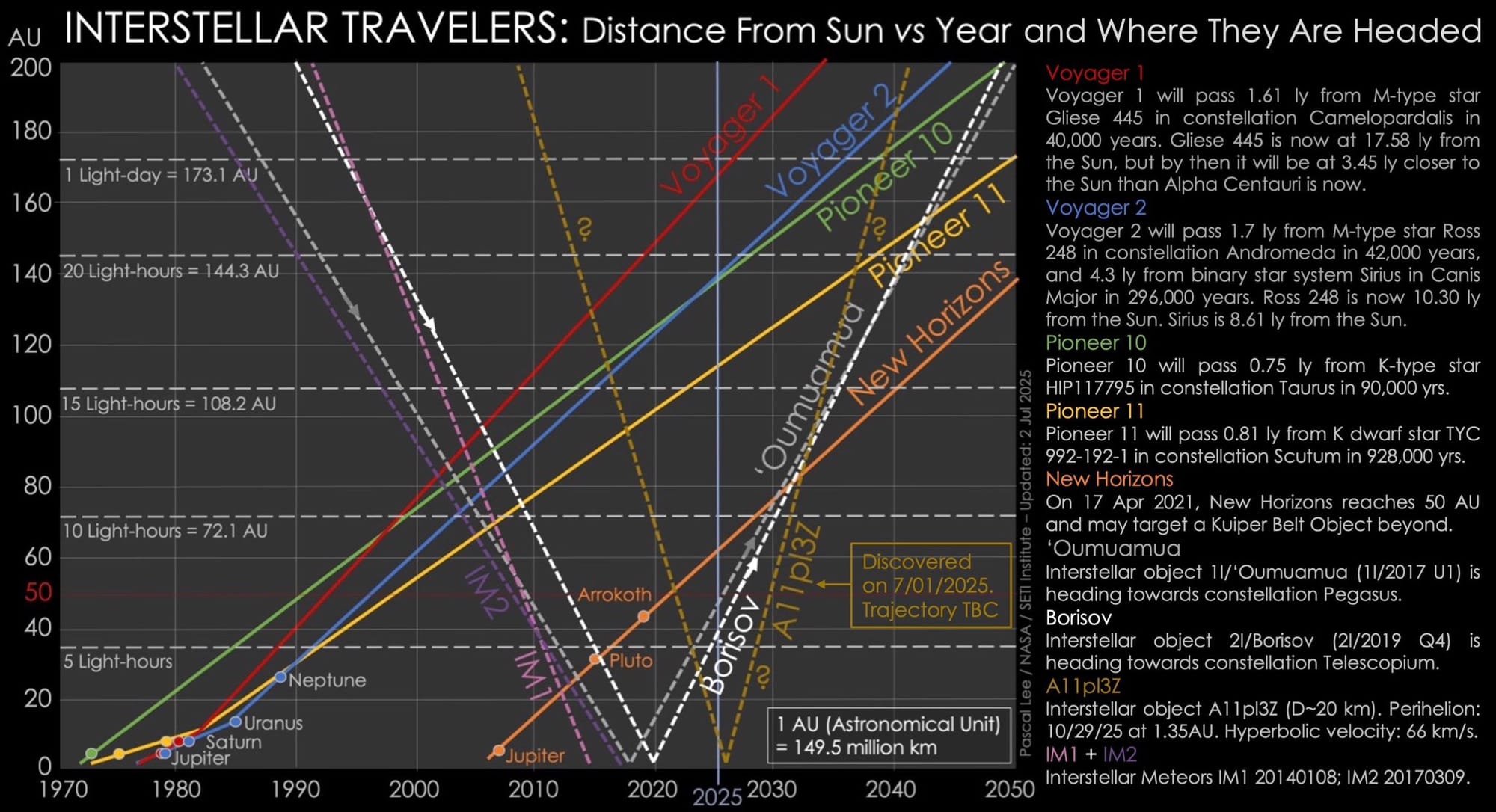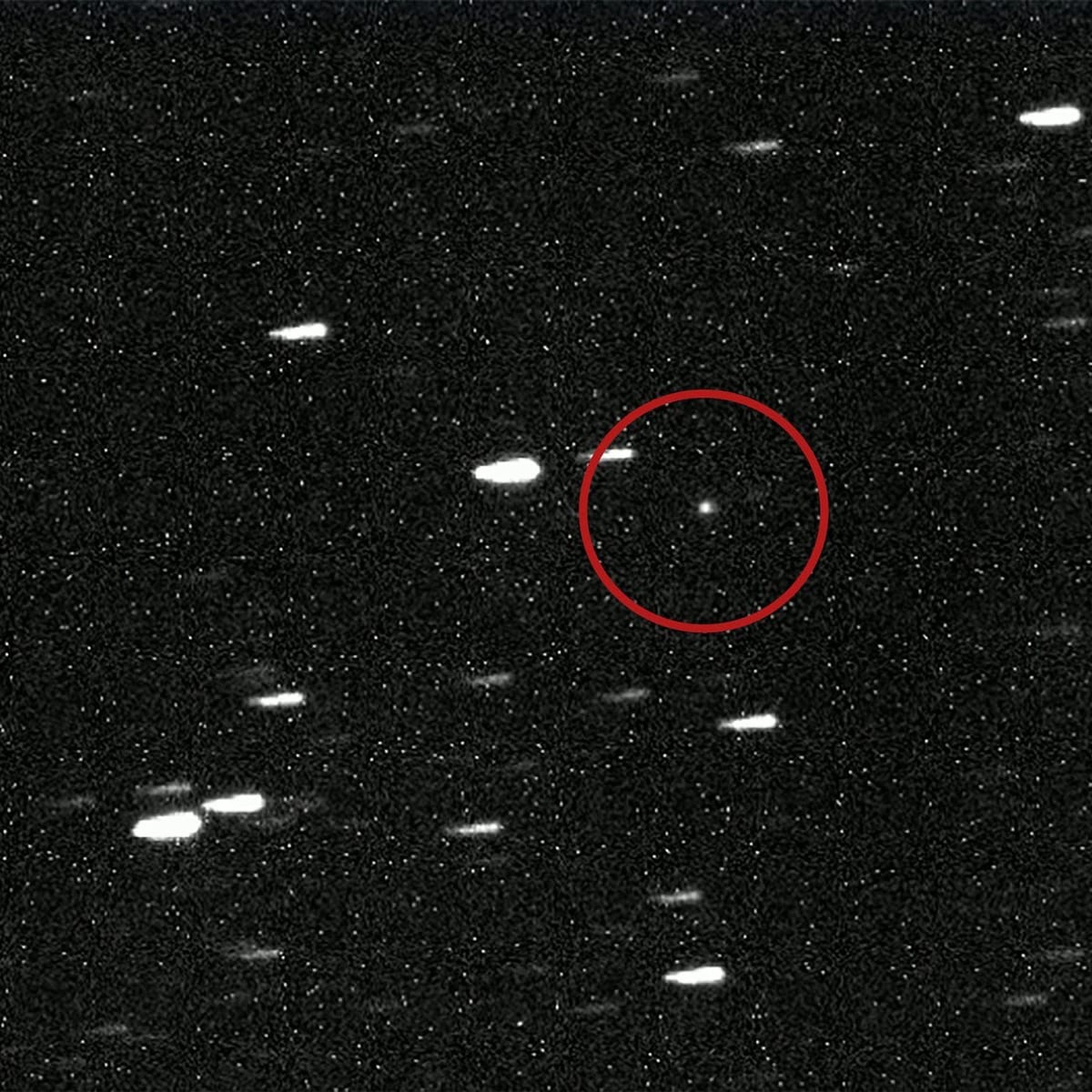Introduction: A Cosmic Traveler from Beyond
On July 1, 2025, the astronomical community was electrified by the discovery of A11pl3Z, a massive object believed to be the third interstellar visitor to enter our Solar System. Likely an asteroid, this 20-kilometer-wide body is speeding through space at 65 kilometers per second on a highly eccentric hyperbolic orbit, a clear sign it hails from beyond our stellar neighborhood. Unlike objects bound to the Sun, A11pl3Z follows a trajectory that will see it whip past our star and exit back into interstellar space, offering a fleeting glimpse of a cosmic wanderer.
This discovery follows in the footsteps of ‘Oumuamua (2017) and Comet Borisov (2019), the only other confirmed interstellar objects to visit our Solar System. However, A11pl3Z stands out with its extraordinary orbital eccentricity of around 6, far surpassing that of its predecessors. Set to reach its closest approach to the Sun, or perihelion, on October 29, 2025, at 1.35 astronomical units (AU), A11pl3Z will pass just outside Mars’ orbit, providing a unique opportunity for study. This article explores the significance of A11pl3Z, its characteristics, and the scientific excitement surrounding this rare interstellar guest.
The Nature of A11pl3Z: A Mysterious Interloper
What is A11pl3Z?
A11pl3Z is a celestial body, provisionally identified as an asteroid, measuring approximately 20 kilometers in diameter. Its discovery on July 1, 2025, was made possible by advanced sky survey systems designed to detect fast-moving objects in our Solar System. Unlike typical asteroids or comets bound to the Sun in elliptical orbits, A11pl3Z follows a hyperbolic trajectory, meaning it is not gravitationally tethered to our star. This characteristic, coupled with its high speed of 65 kilometers per second, confirms its interstellar origin, likely from the thin galactic disk of the Milky Way.
The object’s orbital eccentricity, estimated at around 6, is among the highest ever recorded, far exceeding the eccentricities of ‘Oumuamua (1.2) and Comet Borisov (3.36). An eccentricity greater than 1 indicates an unbound orbit, where the object enters the Solar System, swings past the Sun, and exits without returning. This extreme path suggests A11pl3Z has traveled vast distances across interstellar space, potentially for millions of years, before encountering our Solar System.
Comparison to Previous Interstellar Visitors
A11pl3Z is only the third confirmed interstellar object to be observed in our Solar System, following ‘Oumuamua and Comet Borisov. ‘Oumuamua, discovered in 2017, was a small, cigar-shaped object, roughly 400 meters long, with a reddish hue and no visible cometary activity, leading to debates about whether it was an asteroid or a comet. Its unusual shape and slight non-gravitational acceleration sparked speculation about artificial origins, though natural explanations are widely accepted.
Comet Borisov, identified in 2019, was a more typical interstellar comet, displaying a prominent coma and tail, with a diameter estimated at 1.4 to 16 kilometers. Unlike ‘Oumuamua, it resembled Solar System comets but followed a hyperbolic orbit with an eccentricity of 3.36. A11pl3Z, with its larger size and higher eccentricity, appears distinct from both, potentially offering new clues about the diversity of objects in interstellar space.

The Discovery and Observation of A11pl3Z
How A11pl3Z Was Found
The discovery of A11pl3Z was made on July 1, 2025, by a cutting-edge sky survey system designed to detect near-Earth objects. Additional observations from global telescopes, including those in Chile, Hawaii, and South Africa, confirmed its trajectory and interstellar nature. Pre-discovery images from late June 2025 further refined its orbit, revealing an eccentricity that leaves little doubt about its origins outside our Solar System.
Currently, A11pl3Z is located just inside Jupiter’s orbit, at approximately 3.8 AU from Earth and 4.8 AU from the Sun. It is faintly visible at a magnitude of 18.8, too dim for backyard telescopes but well within the reach of professional observatories. As it approaches perihelion, its brightness is expected to increase, potentially reaching magnitude 11 by October 2025, making it a prime target for detailed study.
Upcoming Observations and Opportunities
A11pl3Z’s journey through the inner Solar System offers a rare chance to study an interstellar object up close. On October 3, 2025, it will pass within 0.2 AU of Mars, close enough for potential imaging by Mars-based assets like the Mars Reconnaissance Orbiter. Its perihelion on October 29, 2025, at 1.35 AU from the Sun, will see it reach a peak speed of approximately 68 kilometers per second, or 152,000 miles per hour. Unfortunately, Earth will be on the opposite side of the Sun during this time, complicating observations due to solar glare.
However, advanced telescopes, such as the recently operational Vera C. Rubin Observatory in Chile and the James Webb Space Telescope, are expected to play a key role in studying A11pl3Z. These instruments will help determine whether the object is a rocky asteroid or displays cometary activity, such as a coma or tail, which could indicate an icy composition. Observations over the coming months will also refine estimates of its size, shape, and surface properties.

The Significance of A11pl3Z’s Hyperbolic Orbit
Understanding Hyperbolic Orbits
A hyperbolic orbit is characterized by an eccentricity greater than 1, meaning the object is not bound to the Sun and will pass through the Solar System only once. A11pl3Z’s eccentricity of approximately 6 is exceptionally high, indicating a nearly straight trajectory that barely bends as it passes the Sun. This suggests the object is moving at a tremendous speed relative to the Solar System, likely originating from the Milky Way’s thin galactic disk, a region dense with stars and planetary systems.
The high eccentricity and speed of A11pl3Z distinguish it from ‘Oumuamua and Comet Borisov, which had eccentricities of 1.2 and 3.36, respectively. This extreme orbit implies that A11pl3Z has not been significantly influenced by the gravitational pull of planets like Jupiter, unlike some Solar System objects that can achieve hyperbolic orbits through planetary encounters. Its trajectory provides a unique opportunity to study the dynamics of interstellar objects and their interactions with our Solar System.
Implications for Its Origin
The direction of A11pl3Z’s approach, at a retrograde inclination of 175 degrees relative to Earth’s orbital plane, suggests it comes from the galactic disk, a region where stars and planets form. This contrasts with objects from the galactic halo, which typically have different trajectories. The object’s high speed and path indicate it may have been ejected from its home star system due to gravitational interactions, possibly involving a massive planet or a close stellar encounter. Studying A11pl3Z could reveal insights into the processes that eject such massive objects into interstellar space.
Scientific Opportunities and Challenges
What We Hope to Learn
A11pl3Z presents a rare chance to study material from another star system. By analyzing its composition, scientists can infer the conditions of the star system where it formed. For example, if A11pl3Z is an asteroid, its rocky surface could provide clues about planetary formation processes in distant systems. If it shows cometary activity, such as a coma or tail, it may reveal information about the volatile-rich environments of its origin.
The object’s size, estimated at 20 kilometers, is significantly larger than ‘Oumuamua (400 meters) and potentially larger than Comet Borisov. This suggests A11pl3Z could be a substantial fragment of a disrupted planet or a massive asteroid ejected from its system. Spectroscopic analysis using advanced telescopes could determine its chemical makeup, while imaging may reveal its shape and surface features.
Observational Challenges
Despite the excitement, studying A11pl3Z poses challenges. Its current faintness (magnitude 18.8) requires powerful telescopes, and its position near the galactic plane complicates observations due to the density of stars in that region. The timing of its perihelion, when Earth is on the opposite side of the Sun, will make it difficult to observe at its brightest. Additionally, its high speed means astronomers have a limited window to collect data before it exits the Solar System.
The uncertainty about whether A11pl3Z is an asteroid or comet adds complexity. Preliminary observations suggest an asteroidal appearance, but signs of cometary activity, such as a faint coma or tail, could emerge as it nears the Sun. These factors will influence size estimates, as cometary activity can inflate brightness measurements.
The Broader Context: Interstellar Objects in Perspective
The Rarity of Interstellar Visitors
Interstellar objects like A11pl3Z are exceptionally rare, with only three confirmed in history. Astronomers estimate that such objects pass through the inner Solar System roughly once a year, but their faintness and high speeds make them difficult to detect. The discovery of ‘Oumuamua in 2017 marked a turning point, as it demonstrated that modern survey telescopes, like Pan-STARRS and ATLAS, could identify these fleeting visitors. The Vera C. Rubin Observatory, now operational, is expected to detect one to ten interstellar objects annually, revolutionizing our understanding of these cosmic wanderers.
What A11pl3Z Tells Us About the Universe
Each interstellar object offers a snapshot of a distant star system. A11pl3Z’s large size and high eccentricity suggest it may have originated from a dynamic environment, possibly a star system with massive planets capable of ejecting such a large body. Its trajectory from the galactic disk hints at a relatively young system, potentially comparable in age to our Solar System (4.6 billion years). By studying A11pl3Z, scientists can piece together the puzzle of how planetary systems form and evolve across the Milky Way.
The diversity among the three known interstellar objects—‘Oumuamua’s cigar-shaped, inert form; Borisov’s comet-like behavior; and A11pl3Z’s massive, highly eccentric nature—highlights the variety of objects in interstellar space. This diversity challenges assumptions about the uniformity of asteroids and comets and underscores the need for continued observation.
Safety and Public Interest
No Threat to Earth
A11pl3Z poses no danger to Earth. Its closest approach to our planet, on October 30, 2025, will occur at 1.35 AU, roughly 200 million kilometers away. This distance, combined with Earth’s position on the opposite side of the Sun during perihelion, ensures no risk of collision. The object’s close pass by Mars (0.2 AU on October 3, 2025) offers a unique opportunity for observation but poses no threat to the Red Planet.
Public Fascination and Speculation
The discovery of A11pl3Z has sparked widespread interest, fueled by the intrigue surrounding ‘Oumuamua, which some speculated could be an alien probe due to its unusual shape and acceleration. While such claims were debunked, A11pl3Z’s unique characteristics have reignited curiosity. Scientists emphasize that it is likely a natural object, but its size and speed make it a compelling subject for both researchers and the public. Online observation events, such as those planned for July 3, 2025, aim to engage enthusiasts by providing live views of the object.
The Future of Interstellar Object Research
Advancements in Detection Technology
The discovery of A11pl3Z highlights the power of modern astronomical surveys. Systems like ATLAS and the Vera C. Rubin Observatory are transforming our ability to detect faint, fast-moving objects. As these technologies improve, astronomers expect to identify more interstellar visitors, potentially revealing a population of objects that pass through our Solar System regularly but have gone unnoticed until now.
Potential for Future Missions
While A11pl3Z’s high speed (65–68 km/s) makes it too fast for current spacecraft to intercept, its discovery has renewed interest in missions to study interstellar objects. Proposals for rapid-response missions, such as those inspired by ‘Oumuamua, could enable future spacecraft to rendezvous with similar visitors, collecting samples or detailed images. Such missions would provide unprecedented insights into the composition of extrasolar material.
A Window to the Cosmos
A11pl3Z represents more than a fleeting visitor; it is a window to the broader universe. By studying its properties, scientists can better understand the processes that govern star and planet formation. The object’s journey through our Solar System, brief as it is, offers a rare chance to connect our cosmic neighborhood to the vast expanse of the Milky Way.
Conclusion: A Fleeting Glimpse of the Universe
The discovery of A11pl3Z on July 1, 2025, marks a milestone in astronomy, confirming the third interstellar object to visit our Solar System. With its 20-kilometer size, 65 km/s speed, and hyperbolic orbit with an eccentricity of 6, A11pl3Z is a unique cosmic traveler, likely originating from the Milky Way’s galactic disk. Its perihelion on October 29, 2025, and close pass by Mars offer a precious opportunity to study an object from another star system, despite challenges posed by its faintness and Earth’s unfavorable position.
As astronomers mobilize global telescopes to observe A11pl3Z, the object promises to deepen our understanding of interstellar space and the diversity of celestial bodies. While it poses no threat to Earth, its presence captivates scientists and the public alike, reminding us of the vast, dynamic universe beyond our Solar System. With advancing technology, discoveries like A11pl3Z will become more common, opening new frontiers in our quest to explore the cosmos.
Q&A: Exploring A11pl3Z, the Third Interstellar Visitor
Q1: What is A11pl3Z, and why is it significant?
A: A11pl3Z is a 20-kilometer-wide object, likely an asteroid, discovered on July 1, 2025. It is the third confirmed interstellar visitor to our Solar System, following a hyperbolic orbit with an eccentricity of 6, indicating its origin beyond our star system. Its study could reveal insights into distant planetary systems.
Q2: How was A11pl3Z discovered?
A: It was detected by advanced sky survey systems, with additional observations from telescopes in Chile, Hawaii, and South Africa confirming its interstellar nature. Pre-discovery images from June 2025 helped refine its orbit.
Q3: What is a hyperbolic orbit, and why does it matter?
A: A hyperbolic orbit has an eccentricity greater than 1, meaning the object is not bound to the Sun and will exit the Solar System after passing. A11pl3Z’s eccentricity of 6 indicates a highly unbound trajectory, confirming its interstellar origin.
Q4: When and where will A11pl3Z be closest to the Sun?
A: A11pl3Z will reach perihelion on October 29, 2025, at 1.35 AU from the Sun, just outside Mars’ orbit. It will pass 0.2 AU from Mars on October 3, 2025.
Q5: Does A11pl3Z pose any danger to Earth?
A: No, A11pl3Z will come no closer than 1.35 AU (200 million kilometers) to Earth on October 30, 2025, and will be on the opposite side of the Sun, posing no threat.
Q6: How can astronomers study A11pl3Z?
A: Global telescopes, including the Vera C. Rubin Observatory and James Webb Space Telescope, will observe A11pl3Z to analyze its composition, size, and potential cometary activity. Its close pass by Mars may allow imaging by Mars-based assets.


